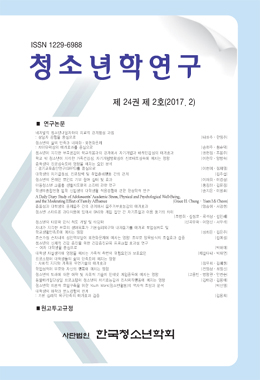본 연구의 목적은 스트레스 취약성 모델을 중심으로 하여 대학생의 생활 스트레스, 수동적 태도, 우울, 무망감이 자살사고에 미치는 경로를 알아보고, 이에 대한 구조모형을 검증해보고자 진행하였다. 이를 위해 서울, 경기도, 강원도 소재의 대학교에 다니는 891명을 대상으로 설문지를 실시하고 분석하였다. 연구결과, 상관분석에서는 스트레스, 수동적 태도, 우울, 무망감이 모두 자살사고와 정적 상관이 있었고, 스트레스, 수동적 태도, 우울, 무망감 간에도 모두 정적 상관이 있었다. 모형검증은 연구자료가 비정규적 분포를 이루기 때문에 Mplus 프로그램의 MLM방법으로 이루어졌고, 연구모형이 최종모형으로 선택되었다. 연구모형은 대학생의 스트레스는 수동적 태도를 통해 우울과 무망감에 각각 영향을 미치고, 수동적 태도는 우울과 무망감의 이중 매개 경로를 통해 자살사고에 영향을 미친다는 경로모형이다. 그리고 스트레스에서 순차적으로 수동적 태도, 무망감, 우울, 자살사고에 영향을 미치는 경로를 포함하는 것이다. 이러한 연구 결과를 바탕으로 자살예방을 위한 방법으로 사회환경적 스트레스의 축소, 개인적인 스트레스 관리 기술 습득, 현실적인 목표설정을 통한 수동적 태도의 개선, 인지행동치료와 자아정체감 형성을 통한 우울 및 무망감 해소의 필요성을 제시하였다. 그리고 본 연구의 의의를 논의하고 후속 연구에 대한 제안을 하였다.
The purpose of this study was to investigate the structural relationship between the Korean college students’ life stress and suicidal ideation. A total of 891 college students completed Stress scale, Passive Attitude Scale, Hopelessness Scale, Depression Scale and Suicidal Ideation Scale. To process the data, correlation analysis using SPSS. WIN 15.0, and a hypothetical testing model using Mplus were applied. The results were as follows: First, stress, passive attitude, hopelessness, depression have a positive correlation with suicidal ideation. Stress, passive attitude, hopelessness, depression have a positive correlation each other. Second, stress predicted depression and hopelessness, both mediated with passive attitude. Then passive attitude predicted suicidal ideation, mediated with depression and hopelessness. The implications and limitation of this study were also discussed together with suggestions for future research.




